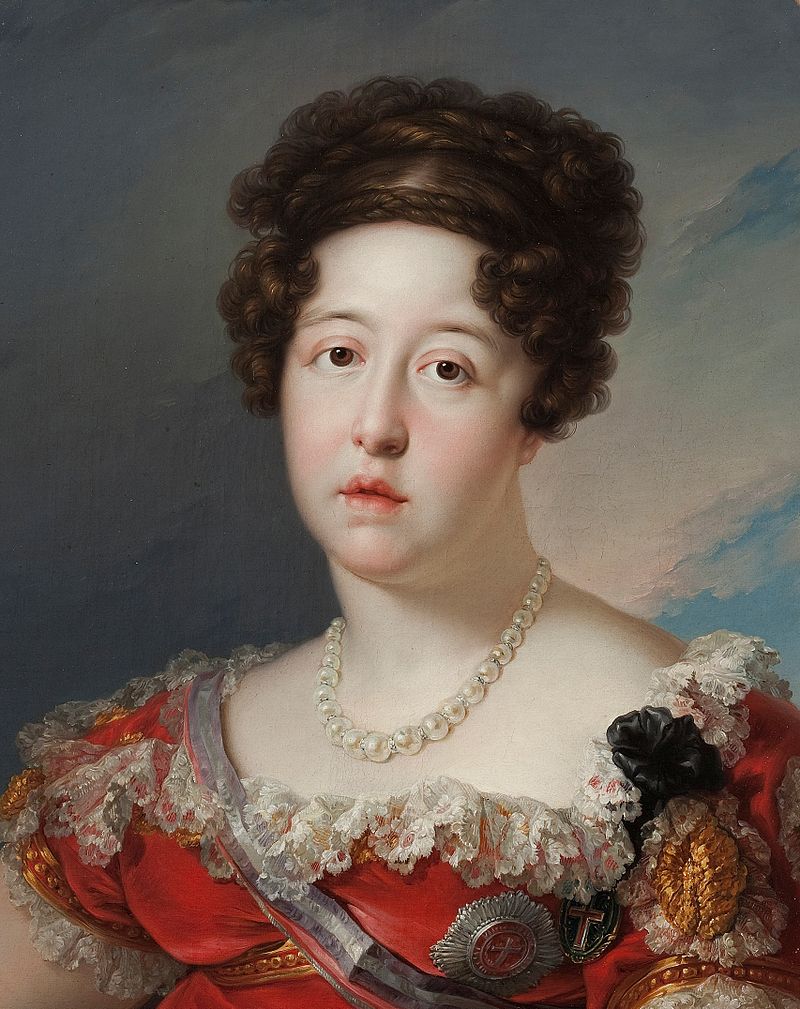© Unofficial Royalty 2024

Elizabeth I, Empress of All Russia; Credit – Wikipedia
December 29, 1709 – Birth of Elizabeth, Empress of All Russia, daughter of Peter I (the Great), Emperor of all Russia and Catherine I, Empress of All Russia, at Kolomenskoye near Moscow, Russia
During the ten-year reign of her cousin Anna, Empress of All Russia, Elizabeth had been gathering support in the background. After the infant Ivan VI succeeded Anna, a conspiracy soon arose to obtain the Russian throne for Elizabeth Petrovna, the only surviving child of Peter I the Great, Emperor of All Russia. A coup occurred during the night of December 5-6, 1741 with financial support from France and military support from the Preobrazhensky Regiment. Empress Elizabeth never married but did have a long-term relationship with and was possibly morganatically married to Alexei Grigorievich Razumovsky, born Alexei Rozum to a Ukrainian-born Cossack. Elizabeth was responsible for renovating and refurbishing three important Romanov palaces – the Winter Palace in St. Petersburg, the Catherine Palace in Tsarskoye Selo, and Peterhof near St. Petersburg. Elizabeth’s court was very lavish and her 21-year reign is remembered as a period of luxury and excess.
Unofficial Royalty: Elizabeth, Empress of All Russia
December 29, 1721 – Birth of Jeanne Antoinette Poisson, Madame de Pompadour, mistress and confidante of King Louis XV of France, in Paris, France
Madame de Pompadour was the official mistress of King Louis XV of France from 1745 until 1750 and continued to serve as one of the King’s closest confidantes until her death.
Unofficial Royalty: Jeanne Antoinette Poisson, Madame de Pompadour
December 29, 1731 – Death of Louise-Hippolyte, Sovereign Princess of Monaco at the Prince’s Palace in Monaco; buried at the Church of Saint Nicholas in Monaco
Louise-Hippolyte was the second but the eldest surviving of the six daughters of Antonio I, Prince of Monaco. Her father decided, with the permission of King Louis XIV of France, that Louise Hippolyte’s husband would take the surname Grimaldi and jointly rule Monaco with her. In 1715, Louise-Hippolyte married French noble Jacques François Leonor Goyon de Matignon. They had nine children but only four survived to adulthood, including Honoré III, Prince of Monaco. When her father died, Louise-Hippolyte decreed that she would be the sole ruler, all documents would be issued in her name only, and her husband and children would stay in France. Louise-Hippolyte had a very short reign of ten months. Several weeks before Christmas of 1731, a smallpox epidemic spread through the Mediterranean coastal areas. Louise-Hippolyte died from smallpox at the age of 34, on December 29, 1731.
Unofficial Royalty: Princess Louise-Hippolyte of Monaco
December 29, 1790 – Death of Maria Teresa Cybo-Malaspina, Duchess of Massa and Carrara, Duchess of Modena and Reggio, wife of Ercole III d’Este, Duke of Modena and Reggio, at the Ducal Palace in Reggio Emilia, Duchy of Modena and Reggio, now in Italy; buried at the Basilica of the Madonna della Ghiara in Reggio Emilia in Duchy of Modena and Reggio, now in Italy
Maria Teresa Cybo-Malaspina, the wife of Ercole III, Duke of Modena and Reggio, was the reigning Duchess of Massa and Carrara in her own right from 1731 until she died in 1790. The marriage was not a happy one. After Maria Teresa gave birth to two children, Ercole humiliated her with his open relationships with his mistresses. Eventually, the couple began to live apart. Maria Teresa and Ercole’s only surviving child Maria Beatrice d’Este married Archduke Ferdinand of Austria, son of Francis Stephen, Duke of Lorraine, Grand Duke of Tuscany, Holy Roman Emperor and Maria Theresa, in her own right Archduchess of Austria, and Queen of Hungary, Croatia, and Bohemia. Maria Beatrice and Ferdinand’s marriage created the House of Austria-Este, a cadet branch of the House of Habsburg-Lorraine. Maria Teresa was an enlightened ruler and demonstrated excellent administrative skills.
Unofficial Royalty: Maria Teresa Cybo-Malaspina, Duchess of Massa and Carrara, Duchess of Modena and Reggio
December 29, 1820 – Death of Pauline of Anhalt-Bernburg, Princess of Lippe, Regent of Lippe, wife of Leopold I, Prince of Lippe, in Detmold, Principality of Lippe, now in North Rhine-Westphalia, Germany; first buried at the Church of the Redeemer in Detmold, later her remains were moved to the Mausoleum at the Büchenberg in Detmold
Pauline of Anhalt-Bernburg was not only Princess Consort of Lippe, she ably served as Regent of the Principality of Lippe for eighteen years during the minority of her son Leopold II, Prince of Lippe. The social work that she started in Detmold, then in the Principality of Lippe, now in the German state of Saxony-Anhalt, continues today with the charity she founded, the Princess Pauline Foundation (Fürstin-Pauline-Stiftung in German). Pauline is considered one of the most important rulers of Lippe. She died, aged 51, from a lung ulceration.
Unofficial Royalty: Pauline of Anhalt-Bernburg, Princess of Lippe
December 29, 1843 – Birth of Elisabeth of Wied, Queen of Romania, wife of King Carol I of Romania, at Schloss Monrepos in Neuwied, Principality of Wied, now in Rhineland-Palatinate, Germany
Full name: Pauline Elisabeth Ottilie Luise
In 1869, Elisabeth married Prince Carol I, born Prince Karl of Hohenzollern-Sigmaringen, who had been elected Ruling Prince of the United Principalities of Romania. They had one daughter, Maria, born in September 1870. Maria died of scarlet fever in 1874, and Elisabeth never fully recovered from the loss of her only child. In 1881, the Romanian parliament declared Romania a Kingdom, and Elisabeth’s husband became King Carol I. A patron of the arts, Elisabeth often hosted writers, composers, and musicians, and helped promote their works. Her true passion was writing. Under the pseudonym Carmen Sylva, she wrote hundreds of poems, plays, novels, short stories, and essays, and thanks to her fluency in several languages, she published numerous translations of other works.
Unofficial Royalty: Elisabeth of Wied, Queen of Romania
December 29, 1916 – Murder of Grigori Efimovich Rasputin at Moika Palace in Saint Petersburg, Russia, home of Prince Felix Yusupov; buried at Tsarskoye Selo, near St. Petersburg, Russia; after the abdication of Nicholas II, Rasputin’s body was exhumed and burned to prevent his burial site from becoming a site of pilgrimage
After working with many physicians to help her hemophiliac son Tsesarevich Alexei Nikolaevich, Empress Alexandra Feodorovna, wife of Nicholas II, Emperor of All Russia, turned to mystics and faith healers. This led to her close, and disastrous, relationship with Grigori Yefimovich Rasputin. Several times he appeared to have brought the Tsarevich back from the brink of death, further cementing Alexandra’s reliance. To many historians and experts, this relationship would contribute greatly to the fall of the Russian monarchy. The belief of Nicholas II’s family in Rasputin’s healing powers brought him considerable status and power. He was suspected of exerting political influence over Nicholas II and was even rumored to be having an affair with Alexandra. Opposition to Rasputin’s influence grew within the Russian Orthodox Church. Even Imperial Family members became concerned with Rasputin’s influence when Nicholas II left St. Petersburg to take supreme command of the Russian armies fighting in World War I, leaving Alexandra in charge as Regent. Eventually, a group of conspirators plotted to murder Rasputin hoping to end his influence over Nicholas II’s family. Nicholas II, Emperor of All Russia’s first cousin Grand Duke Dmitri Pavlovich and his niece’s husband Prince Felix Yusupov were among the conspirators.
Unofficial Royalty: Murder of Grigori Yefimovich Rasputin
Unofficial Royalty: Grigori Efimovich Rasputin
December 29, 1954 – Birth of Prince Takamado of Japan in Tokyo, Japan
Prince Takamado was the son of Prince Mikasa of Japan and Yuriko Takagi (Princess Mikasa). Takamado’s father Prince Mikasa was the youngest son of Emperor Taishō, the youngest brother of Emperor Hirohito (Shōwa), and the uncle of Emperor Akihito. Takamado worked from 1981 until he died in 2002 as the administrator of the Japan Foundation which promotes Japanese arts, culture, and language exchange around the world. In 1984, he married Hisako Tottori, the eldest daughter of a Japanese industrialist and the couple had three daughters. In 2002, while playing squash with the Canadian ambassador Robert Wright at the Canadian Embassy, Prince Takamado collapsed due to ventricular fibrillation. He was immediately taken to the hospital but was already in a state of cardiopulmonary arrest. He was resuscitated but his condition then worsened and soon there was no hope that he would survive. With the consent of his wife, Prince Takamado was removed from life support and died at the age of 47.
Unofficial Royalty: Prince Takamado of Japan
December 29, 1994 – Birth of Princess Kako of Akishino, daughter of Crown Prince Akishino, at the Imperial Household Agency Hospital in Tokyo, Japan
Kako is the younger of the two daughters of Crown Prince Akishino. In 2021, her elder sister Mako married Kei Komuro, lost her title, and became a commoner upon marriage as required by Imperial Household Law. Her brother Hisahito, the only nephew of Emperor Naruhito, the current Emperor of Japan, is currently second in the line of succession to the Chrysanthemum Throne after his father. In March 2019, Kako graduated from the International Christian University in Tokyo, Japan with a degree in psychology. Since May 2021, Princess Kako has been employed part-time at the Japanese Federation of the Deaf.
Unofficial Royalty: Princess Kako of Akishino
This article is the intellectual property of Unofficial Royalty and is NOT TO BE COPIED, EDITED, OR POSTED IN ANY FORM ON ANOTHER WEBSITE under any circumstances. It is permissible to use a link that directs to Unofficial Royalty.










